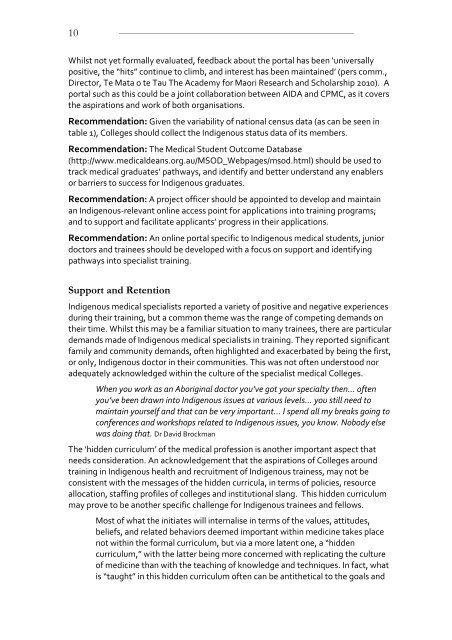View - LIME Network
View - LIME Network
View - LIME Network
Create successful ePaper yourself
Turn your PDF publications into a flip-book with our unique Google optimized e-Paper software.
10Whilst not yet formally evaluated, feedback about the portal has been ‘universallypositive, the “hits” continue to climb, and interest has been maintained’ (pers comm.,Director, Te Mata o te Tau The Academy for Maori Research and Scholarship 2010). Aportal such as this could be a joint collaboration between AIDA and CPMC, as it coversthe aspirations and work of both organisations.Recommendation: Given the variability of national census data (as can be seen intable 1), Colleges should collect the Indigenous status data of its members.Recommendation: The Medical Student Outcome Database(http://www.medicaldeans.org.au/MSOD_Webpages/msod.html) should be used totrack medical graduates’ pathways, and identify and better understand any enablersor barriers to success for Indigenous graduates.Recommendation: A project officer should be appointed to develop and maintainan Indigenous‐relevant online access point for applications into training programs;and to support and facilitate applicants’ progress in their applications.Recommendation: An online portal specific to Indigenous medical students, juniordoctors and trainees should be developed with a focus on support and identifyingpathways into specialist training.Support and RetentionIndigenous medical specialists reported a variety of positive and negative experiencesduring their training, but a common theme was the range of competing demands ontheir time. Whilst this may be a familiar situation to many trainees, there are particulardemands made of Indigenous medical specialists in training. They reported significantfamily and community demands, often highlighted and exacerbated by being the first,or only, Indigenous doctor in their communities. This was not often understood noradequately acknowledged within the culture of the specialist medical Colleges.When you work as an Aboriginal doctor you’ve got your specialty then… oftenyou’ve been drawn into Indigenous issues at various levels… you still need tomaintain yourself and that can be very important… I spend all my breaks going toconferences and workshops related to Indigenous issues, you know. Nobody elsewas doing that. Dr David BrockmanThe ‘hidden curriculum’ of the medical profession is another important aspect thatneeds consideration. An acknowledgement that the aspirations of Colleges aroundtraining in Indigenous health and recruitment of Indigenous trainess, may not beconsistent with the messages of the hidden curricula, in terms of policies, resourceallocation, staffing profiles of colleges and institutional slang. This hidden curriculummay prove to be another specific challenge for Indigenous trainees and fellows.Most of what the initiates will internalise in terms of the values, attitudes,beliefs, and related behaviors deemed important within medicine takes placenot within the formal curriculum, but via a more latent one, a “hiddencurriculum,” with the latter being more concerned with replicating the cultureof medicine than with the teaching of knowledge and techniques. In fact, whatis “taught” in this hidden curriculum often can be antithetical to the goals and
















